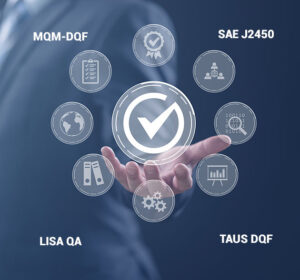

In the translation industry, accuracy and quality matter above all else. If your translations are not accurate, you could be misunderstood by others, cause offense, or come off as nonsensical. Inaccuracy could result in your documents being rejected by government agencies or your business losing out on customers and money; this is why it's so essential that the document translation services you utilize have a quality control process in place for everything translated.
But how do you measure and evaluate translation quality? This article will look at some of the industry standards and common metrics for translation quality. With this information, you will be better able to ensure that any service you use goes through the proper steps to guarantee quality.
What is Translation Quality Control?
Before we get into the metrics, let's clarify what translation quality control is. Translation quality control ensures that translated documents are at an acceptable level of accuracy and quality. This process generally includes steps like editing, proofreading, and testing by native speakers.
To help measure and test these different areas, a large variety of metrics and standards are in use.
What Are the Metrics and Standards for Translation Quality Control?
Metrics
Many different standards for translation have been developed and established over the years. Most of the differences in these standards relate to the industries they are created to serve.
You have options like the MQM-DQF, the LISA QA, and the SAE J2450. The SAE J2450 metric, for example, was primarily a popular standard in the manufacturing industry and takes into account areas such as structure, spelling, terminology, and several others. However, as time has gone on, and the types of content needing to be translated have expanded, organizations like TAUS and The German Research Center for Artificial Intelligence have begun to create new metrics for the digital age and for helping in official document translation.
In 2012 the TAUS DQF (Dynamic Quality Framework) was launched, and among other things, applies a set of standard metrics that calculate translation productivity and quality. DQF-MQM refers to Multidimensional Quality Metrics (MQM) and is another (overlapping) set of metrics that offers translators a standard model for most contexts.
For those not active in the translation industry, you simply need to ensure that whatever organization you use for your translations has a robust set of key performance indicator (KPIs) and a system for measuring them accurately.
Some essential KPI's that a translation company should be measuring or evaluating include
Accuracy: This metric measures how closely the translation matches the source text in meaning, grammar, and style.
Fluency: How well the translated text flows and reads like original, natural language.
Terminology: How well the translator understands and how correctly he/she uses technical terms.
Layout: How well the translated text fits into the design of the target document, including things like line breaks, page numbers, and headers/footers. Very important for official document translation.
Cultural Relevance: How well the translation considers cultural differences between the source and target cultures. It also assesses whether the translation is offensive or insensitive to any group of people.
Standards
There are several business standards that the best translation companies will meet. The most common is the ISO 9000 family, including ISO 9001, 9004, and 19011. These standards are designed to help businesses improve their quality management systems and are not specific to the translation industry, but they can be applied to any business.
To be certified by the ISO, companies must meet specific requirements and undergo audits. The requirements vary depending on the standard, but they generally include having a quality management system in place, documenting procedures, and ensuring that employees are trained and competent.
The standards are voluntary, but many companies pursue them because they demonstrate a commitment to quality. Translation companies certified by the ISO can show their clients that they are serious about providing high-quality services. Not all translation companies are accredited by the ISO, but many of the best ones are.
The EN 15038 quality standard is a translation industry-specific standard. It was developed by the European Union and includes requirements for aspects like quality management systems, translator qualifications, and project management. Like the ISO standards, companies must meet specific requirements to be certified by EN 15038. The standard is voluntary, but it is becoming increasingly common for companies to pursue it.
Many document translation services are also members of professional associations such as the American Translators Association or the UK's Association of Translation Companies. These organizations have their own code of conduct that member document translation services must adhere to. Being a member of a professional association shows potential clients that a company is serious about providing high-quality official document translation services.
Need High Quality Translation Services?
If you are on the hunt for an affordable, top-quality and award-winning translation service, then we have great news. The Spanish Group meets all the strictest standards for quality in the translation industry and we typically only work with the top 1% of translators working today.
Whether you want to translate a single document from English into Spanish (or into any of the 90+ other languages that we offer) or create an entire employee manual or even create a medical label for a new service area, The Spanish Group is here for you.
Should I Automate Translation Quality Control?
All businesses need to improve efficiency and quality while reducing costs. Many companies are finding that automation can be a valuable tool in achieving just that when it comes to translation quality control. Automation can help you speed up the editing process and can ensure your translators are putting in work of consistent quality. However, there are also some drawbacks involved.
In this article, we will briefly go over the idea of automating translation quality control, where it may be applied, and where it may be a bad idea and why.
Is it a Good Idea to Automate Translation Quality Control?
Both approaches have pros and cons, and the best decision comes down to what will work best for you. Primarily, you need to consider the size and complexity of your translation projects.
If you have a lot of text to translate and a small budget, then automation may be the best way to ensure a basic quality level. However, if your translations are very technical, are for official documents, or are in a less common language, then you will want to stick with properly vetted document translation services.
Automation may be 98% accurate when used to help translate a document from English into Spanish (according to some recent Google metrics), but this drops significantly when you include fewer common languages. Also, 98% is still not very high when you think about how many errors that is in a 1000-word document and how that would reflect on a brand.
Ultimately, the best way to decide whether or not to automate translation quality control is to evaluate your specific needs and see what approach will work best for you. Just make sure you eventually have a plan in place to ensure the quality of your translations.
What Tools are Used in Automated Translation Quality Control?
Many different tools can help automate translation quality control. Here are some of the top options:
Translation Memory Software
These tools store previously translated text in a database, which is then used to translate new texts automatically. This is a way to ensure consistent translations across many very similar documents. These have also become complex step-by-step programs that help translators carefully examine and quickly review documents segment by segment.
Spelling and Grammar Checkers
These programs automatically check the translations for spelling and grammar errors, which can help save a great deal of time and will help to ensure accuracy in the final translation. This can be as simple as what comes bundled in with Microsoft Word or as advanced as programs like Grammarly, though the language in question will often dictate which are the best programs to use.
Terminology Management Tools
These tools help to create and maintain glossaries of terms that should be used in a particular translation project. This can help ensure that all translators use the same terminology and translate consistently. This can be especially helpful in fields where there is specialized vocabulary.
There are many similar quality assurance tools for particular industries or niche purposes, most of which check translations against a set of rules to ensure accuracy and consistency.
Why Should Human Editors Be Used to Review Most Translations?
Simply put, automation may not be suitable for all types of translations. Here are some reasons why you may not want your translation quality control and general editing automated:
- Many governments worldwide still require properly certified human translators for legal purposes. This applies to most types of official translations.
- The human brain is still better at catching context clues and nuances in language. This is particularly true for idiomatic expressions, metaphors, and other figurative language. An automated system will simply translate the words that it sees and will not understand their meaning.
- Automated translation quality control systems also are not able to properly review some types of content. This includes highly technical documents with particular terminology. Automating quality control for localization or transcreation projects can also be challenging.
- It is also important to remember that you can never entirely remove human error. There are still errors that can be made by a quality control team not fully trained in using the new system.
This is not to say that you should never automate your translation quality control. If you have a large volume of text that needs to be reviewed; it may be more efficient to use an automated system. You will just need to make sure that you supplement it with a human review for important or sensitive projects.
What Is a Perfect Translation? We Will Help You Achieve It!
In an official document translation or the translation of a technical document, a 'perfect translation' can usually be described as one that is without any mistakes and makes exact word-for-word (or as close as possible) recreation of the original document in a new language. This is a standard in many services.
However, in most other contexts, a 'perfect translation' may not be the one that uses the most literal words but conveys the original document's correct intention, emotion, and meaning. The best document translation services need to be capable of what is called 'transcreation.'
Transcreation refers to the act of adapting a message from one language to another while keeping the same intent, style, tone, and context of the original message. It is essential in marketing and advertising campaigns that need to be localized for different markets. Transcreation requires a creative mind to ensure that a message properly resonates with the target audience. This may involve changing idiomatic expressions, wordplay, and cultural references. Transcreation is a complex process that requires deep knowledge of both the source and target cultures.
As such, it is typically done by native speakers of the target language who are also intimately familiar with the source culture. This is why at The Spanish Group, we use only the very best translators with real-world experience in both their languages as well as the industries they translate for. With The Spanish Group, you are always guaranteed a 'perfect' translation no matter the context.
















